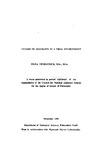Studies of sediments in a tidal environment
| dc.contributor.author | Fitzpatrick, Fiona | |
| dc.contributor.other | School of Geography, Earth and Environmental Sciences | en_US |
| dc.date.accessioned | 2011-06-28T15:16:31Z | |
| dc.date.available | 2011-06-28T15:16:31Z | |
| dc.date.issued | 1991 | |
| dc.identifier | Not available | en_US |
| dc.identifier.uri | http://hdl.handle.net/10026.1/513 | |
| dc.description.abstract |
Five sedimentary environments in Plymouth Sound, S.W. England, are defined by side-scan sonar surveys calibrated by direct sampling by SCUBA divers: (i) uniform mud depocentres, (ii) areas of continual sediment reworking, (iii) areas of relict sedimentation, (iv) areas of episodic deposition and, (v) clean-washed rock outcrops. Net sediment transport paths are defined using the physical properties of the sediment. Analysis of Airborne Thematic Mapper and Compact Airborne Spectographic Imager scanner data at High and Low Water, with concurrent sampling has enabled the relationship to be established between suspended sediment concentration, percentage organics, temperature and salinity and a marked continuity between the sea bed and some surface water properties has been defined. Such techniques identify previously-unrecognized features such as tidal gyres above areas of featureless acoustic response. The anistropy of magnetic susceptibility of diver-orientated samples, showed that the primary fabric of their sediments is controlled by modal sediment size, magnetic mineralogy and the type and intensity of the water currents. The effect of biogenic disturbances and the re-establishment of magnetic alignment under different depositionary controls are significant features in the development of secondary fabric. The combination of these results has defined the history of the ancestral inlet throughout the Late Quaternary, which is shown to have been controlled by the lithology, the structure of South West England and the climatic changes experienced by the region and the English Channel. The development and characteristics of the present day hydrodynamical regime, its adaptation to the presence of the Breakwater and the response of the sea bed to this feature are identified by combining information from these techniques. | |
| dc.language.iso | en | en_US |
| dc.publisher | University of Plymouth | en_US |
| dc.title | Studies of sediments in a tidal environment | en_US |
| dc.type | Thesis | |
| dc.identifier.doi | http://dx.doi.org/10.24382/3659 | |
| dc.identifier.doi | http://dx.doi.org/10.24382/3659 |
Files in this item
This item appears in the following Collection(s)
-
01 Research Theses Main Collection
Research Theses Main


